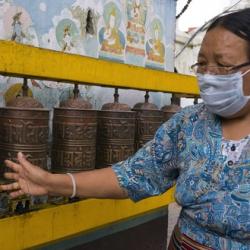 In the US, many health care woes are blamed on the federal or state government. Whether there is too little oversight and lack of transparency or too much interference and regulation, it seems that policy and politics often end up getting blamed for health care system troubles. But what happens when one lives in a country with no functioning government?
In the US, many health care woes are blamed on the federal or state government. Whether there is too little oversight and lack of transparency or too much interference and regulation, it seems that policy and politics often end up getting blamed for health care system troubles. But what happens when one lives in a country with no functioning government?
 In the US, many health care woes are blamed on the federal or state government. Whether there is too little oversight and lack of transparency or too much interference and regulation, it seems that policy and politics often end up getting blamed for health care system troubles. But what happens when one lives in a country with no functioning government? As one of the poorest countries in the world, with little to no government structure, Nepal has learned that health-related needs depend on local communities as well as international aid. Despite the vast differences between our countries, we have a lot to learn from one another about the underserved, health and decreasing disparities in access and outcomes.
In the US, many health care woes are blamed on the federal or state government. Whether there is too little oversight and lack of transparency or too much interference and regulation, it seems that policy and politics often end up getting blamed for health care system troubles. But what happens when one lives in a country with no functioning government? As one of the poorest countries in the world, with little to no government structure, Nepal has learned that health-related needs depend on local communities as well as international aid. Despite the vast differences between our countries, we have a lot to learn from one another about the underserved, health and decreasing disparities in access and outcomes.
Even with Nepal’s reliance on foreign assistance and continual poor health rankings, the US could learn a lot about a return to local or “community care.” Those in developing countries like Nepal have no alternatives. With poor infrastructure, unpredictable electricity and heat, and mountainous geographic barriers, the people of Nepal depend on local leaders and village health providers to care for the country’s millions of people. While Americans grapple with government involvement in the health sector, the Nepalese are now well versed in the pros and cons of no government organization.
In contrast, the Nepalese are looking to their allies from the States to help facilitate safe and fair democratic elections by the end of 2013.
In Nepal, the Constituent Assembly functioned in place of Parliament for many years, until its dissolution in May of 2012, often leaving health decisions and progress at a standstill. The developing country, which sits in the Himalayas and is home to eight of the world’s ten tallest mountain ranges, ranks 157 on the World Health Organization’s overall 2013 human development index. Moreover, Nepal has recently emerged from a decade-long armed insurgency creating an environment of insecurity and conflict that has only intensified poverty.
At present, the average Nepali spends only 5% of their annual income on health-related needs. According to the US State Department, “Nepal is one of the poorest countries in the world … The country faces several medium- and long-term development challenges, including strained capacity in government, civil society and the private sector to drive the development agenda, high vulnerability to climate change and a massive youth bulge.” Although surprisingly, despite economic troubles, Nepal has used its international aid partners and community-based health structure to become one of very few countries in the world on target to meet several Millennium Development Goals (MDGs).
The immobility of government has lead to geographical pockets where resources are almost nonexistent and dependency on foreign aid is great. Both the State Department and the US Agency for International Development (USAID) are working diligently in the capitol of Kathmandu to create sustainable health care programs that foster education, improve health outcomes and promote financial independence. However, it is difficult to see vast improvements in health outcomes and health equality without an active role by the people’s own government.
One of the added difficulties for health advancement is the country’s overwhelming number of natural disasters. Nepal is one of the most disaster-prone countries on earth. Annually, people experience floods, landslides, droughts, epidemics and persistent seismic activity. Due to these extreme difficulties, in tandem with direct health efforts USAID has created programs unique to Nepal, like the Program for Enhancement of Emergency Response (PEER) which aims at improving education on how to appropriately carry out activities such as search and rescue efforts in collapsed buildings and reduce health risks during disasters.
In addition to USAID, there are several local and international organizations that concentrate on improving health in Nepal and meeting MDGs. One specific organization that has focused on health and care in rural areas for more than 20 years is Himalayan Healthcare, a non-profit organization that specializes in creating viable programs in regions where health posts go unstaffed and undersupplied by the local government. “Rural Nepal, almost universally, has mostly rudimentary health care services which are inadequate but still go a long way if caring village health providers are available,” says Anil Parajuli, Himalayan Healthcare’s co-founder and Nepal-based Program Coordinator.
Like many community health centers in the US, serving both rural and urban communities, the Himalayan Healthcare model is not based on one’s ability to pay. Their mission is to treat anyone regardless of his or her gender, sex, caste, profession, or ability to pay. The President of the Himalayan Healthcare’s Board, Dr. Robert McKersie, believes that the US and Nepal have a lot to learn from one another. He claims that what makes a community center successful in either country is, “having input from the local stakeholders from day number one. Before this can happen the providers have to be accepted by, and have legitimacy with, the stakeholders.”
Dr. McKersie contends this acceptance does not always come easily. “Many of these communities (both Nepalese and underserved communities in the States) have historically been used or misled by ‘outsiders’. The buy in process for us was health care. After Himalayan Healthcare proved itself, we were ‘invited’ to help with what became the other two tenets of our community development model, namely education and income generation.” He goes on to say that, “organizations in the States that have done good community medicine know this model of having the community members have a stake in their healthcare.”
With so many differences, yet so many similarities in our underserved populations, it is no wonder health care providers in the US and Nepal view one another as a source of knowledge and inspiration.
At present, the next scheduled elections in Nepal have been set for November 2013.







_5-250x220.jpg)
